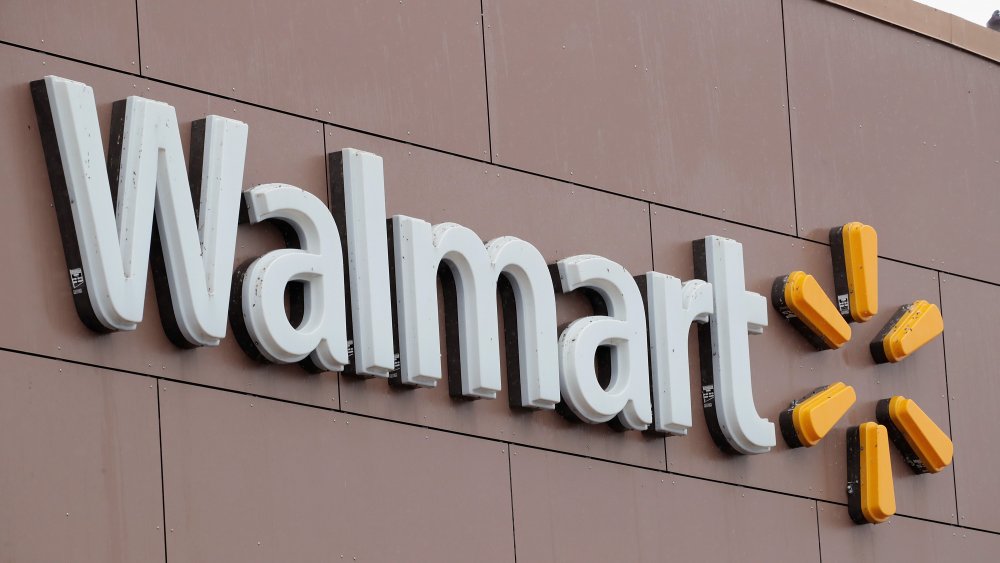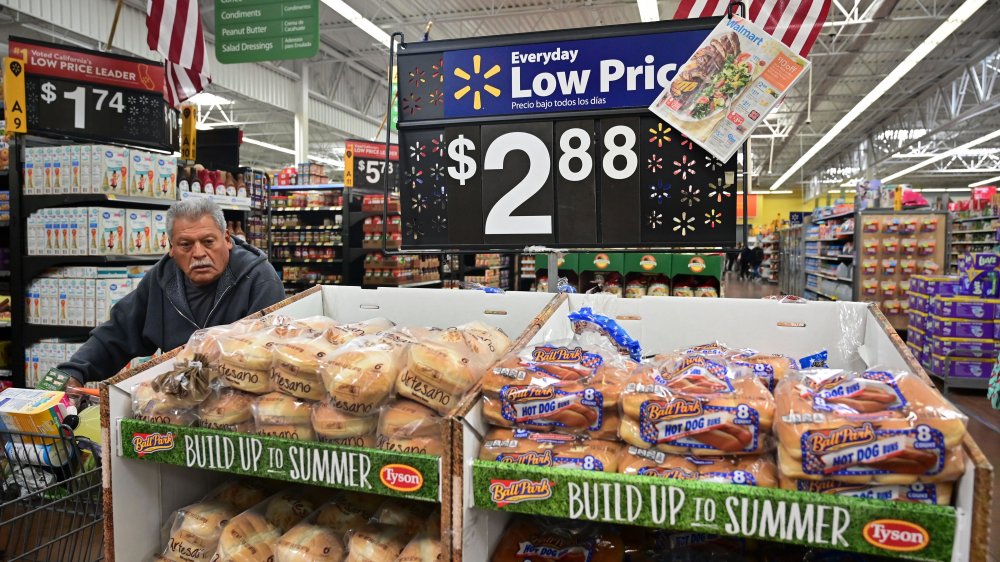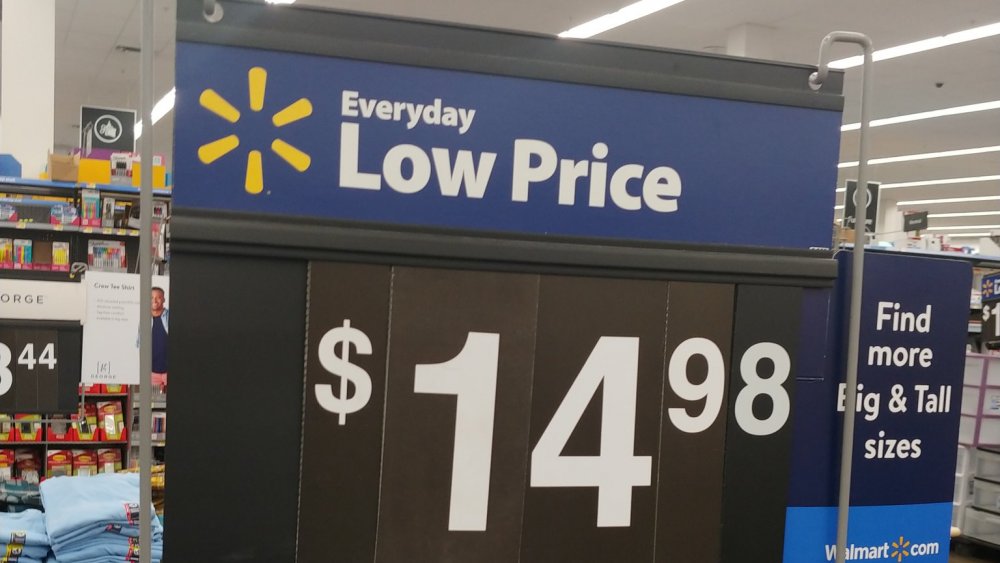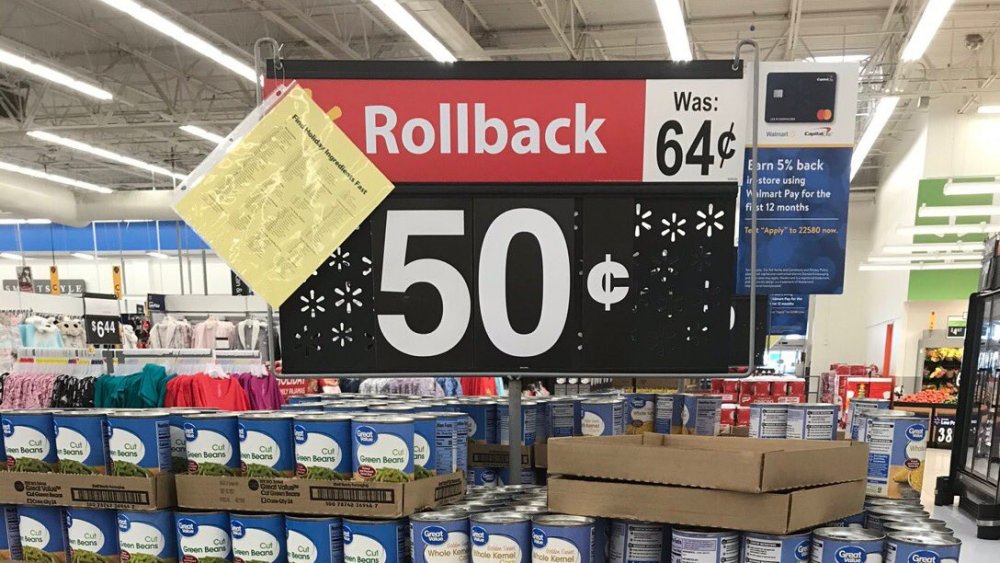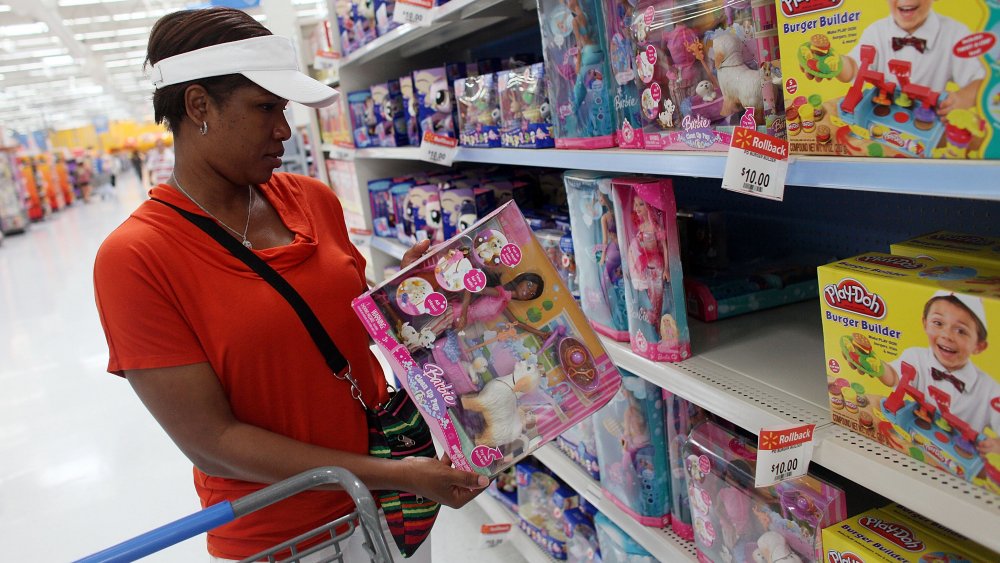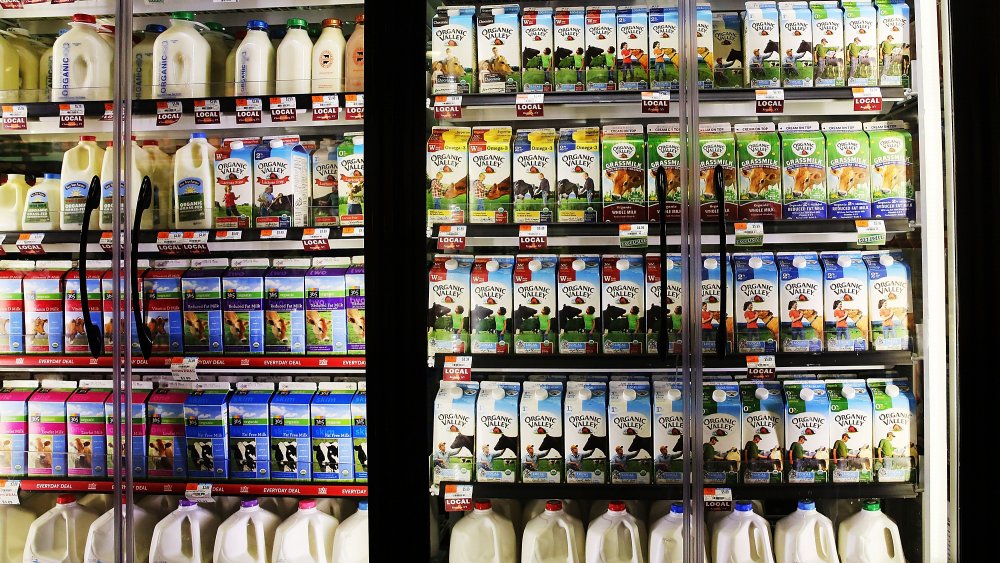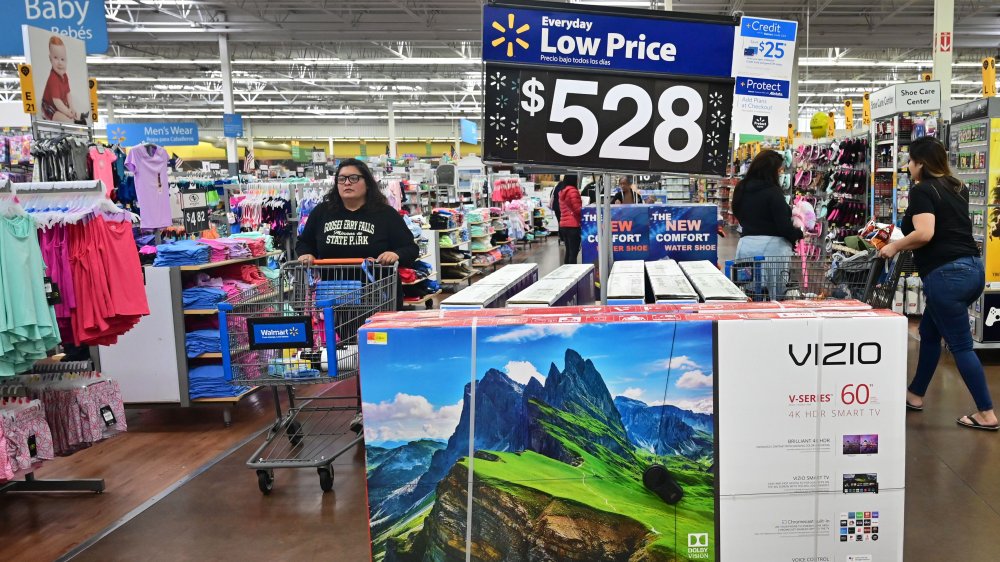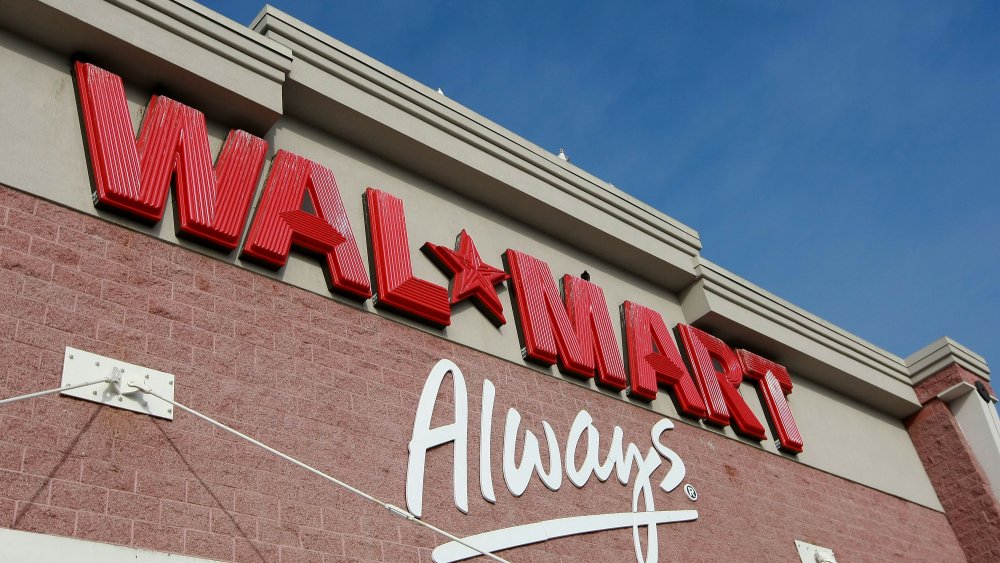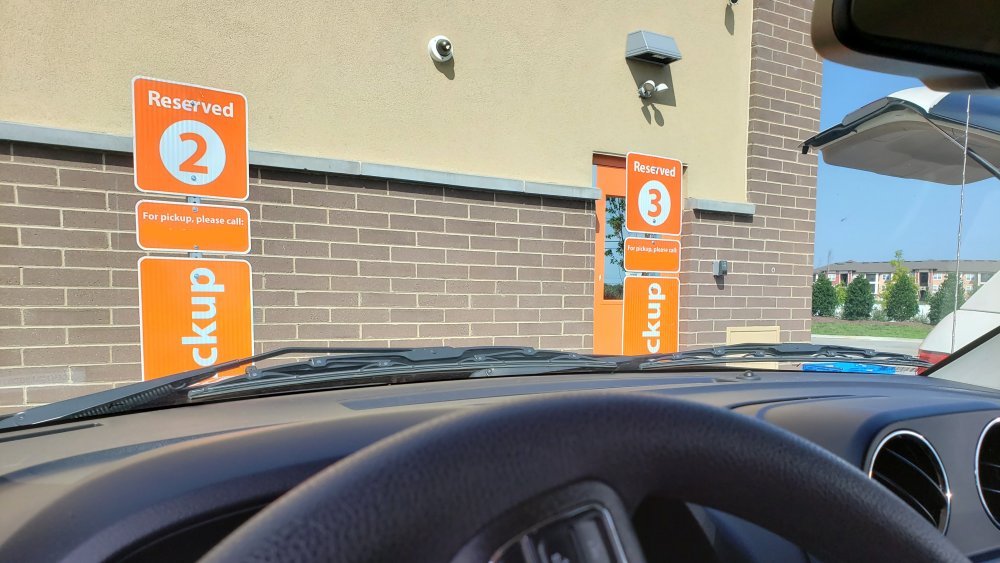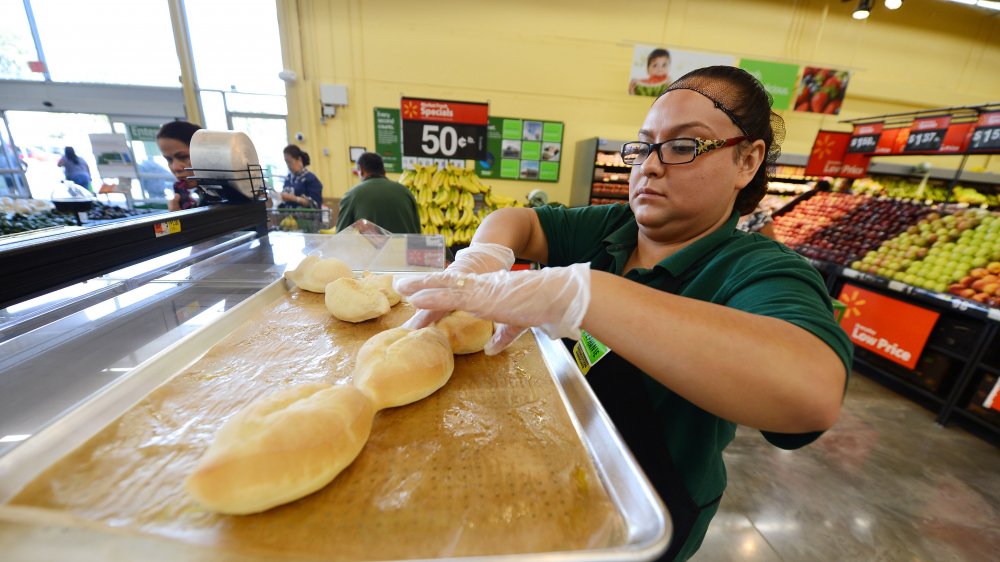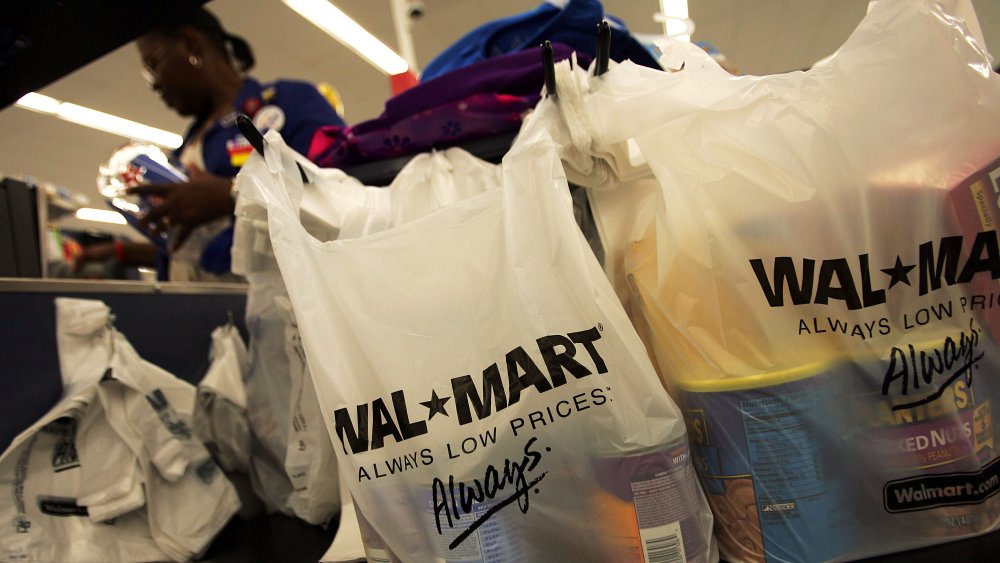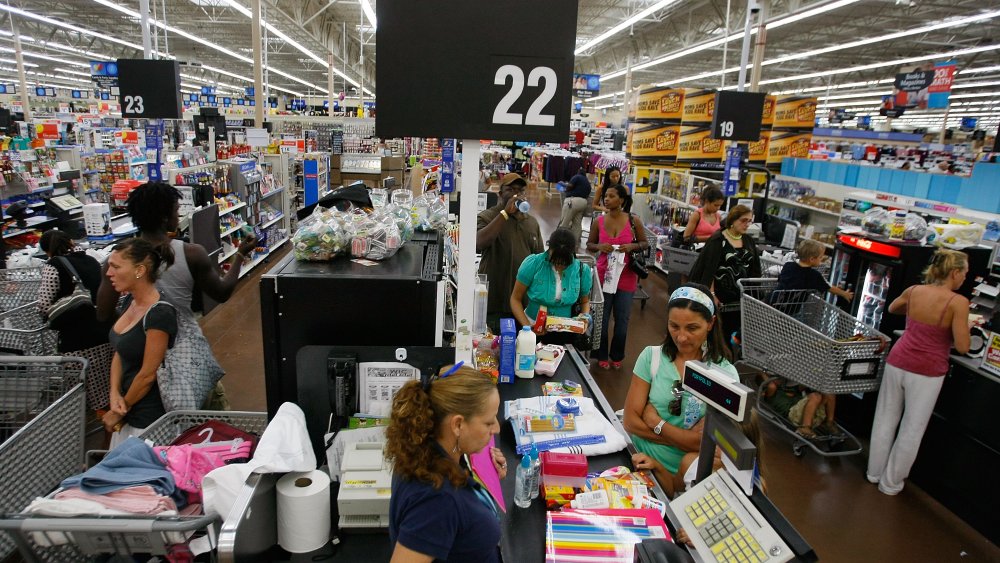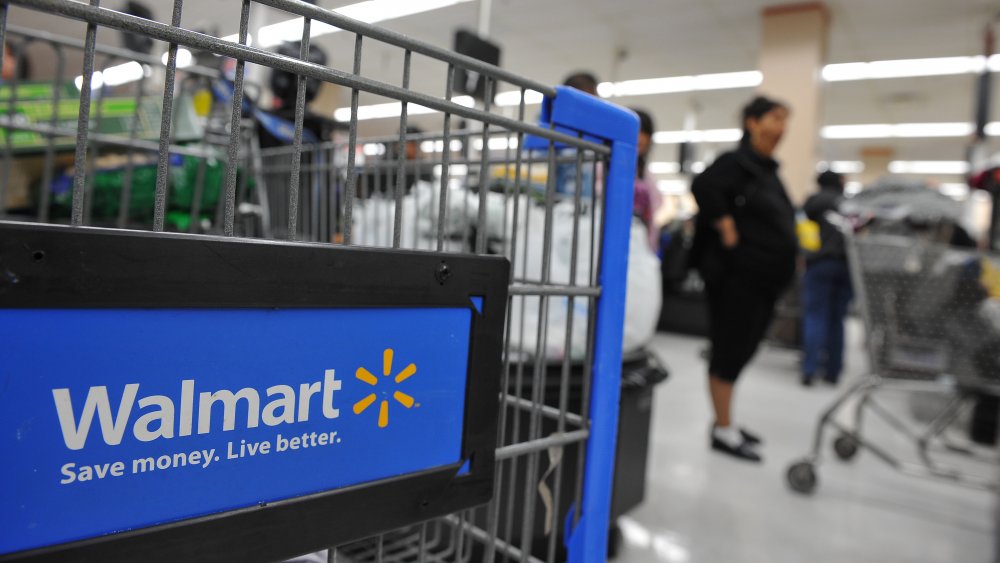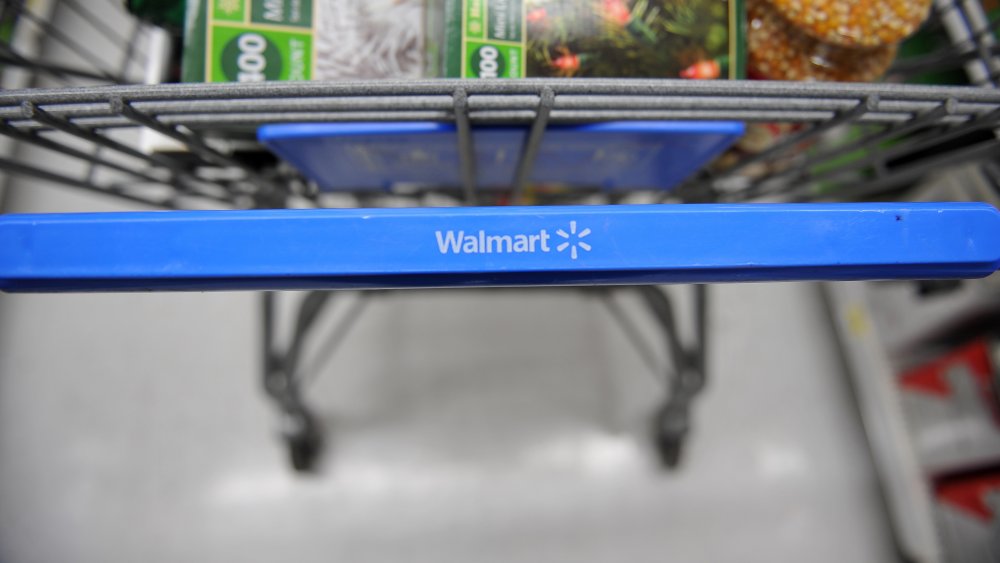Sneaky Ways Walmart Gets You To Spend More Money
Some people can't stand making a trip to Walmart, while others hit up the megastores for everything from their groceries to their holiday shopping. The fact of the matter is, most people shop at Walmart — at least occasionally. According to a 2017 CNBC article, 95 percent of Americans spent money at Walmart in 2016. Yes, Walmart even pulled more shoppers than Jeff Bezos' mighty Amazon empire.
Walmart's giant stores carry just about everything under the sun and they've built a reputation in retail for having prices lower than the rest of the competition. They're also really, really good at getting people to spend money. Walmart has had plenty of time to refine its retail marketing tricks and they've picked up a few very effective strategies in the 50-something years they've been in business.
Trust us, resistance is futile, Walmart will get your money, and here's how the retail giant does it.
Walmart uses the retail trick of odd-even pricing
Besides convenience, the big reason that so many people flock to Walmart to do their shopping is for those low prices. The prices for many items are posted on large signs throughout the store, and you've perhaps noticed that they're not usually whole numbers like $10, $25, etc. More often than not, they'll be odd-even numbers such as $7.82 or $29.93.
Sure, Walmart could round them up to whole numbers, but odd-even pricing in retail is a powerful marketing tool that uses some psychology to make more sales. Over 90 percent of prices in advertisements are posted this way and it all has to do with how we read from left to right. Because of this, the first digit in the price carries the most weight in our minds and $7.95 is going to seem like a better deal than $8, even if there are only a few pennies between the two prices (via Entrepreneur).
Walmart, of course, is hardly the only one using this pricing strategy, but it's a powerful one and is pretty effective in getting shoppers to spend more money on what their eyes see as a bargain.
Walmart constantly reminds shoppers of "everyday low prices"
Low prices are what Walmart has been pushing for decades now to win over consumers. Mom and pop might have known the customer's name, but they just couldn't compete with those everyday low prices. The slogan has changed over the years, the message is still the same.
Walmart wants to make sure customers know they're inside a low price paradise and drills this message home by plastering the message all over the store. Business Insider spent nearly two hours inside a Walmart and reported that they probably counted 100 signs advertising the message. Maybe you only planned on buying one pair of socks, but when the prices are so low, why not grab an extra pair? That sort of in-your-face advertising can really seep into the subconscious of shoppers and result in major sales profits.
As Strategy + Business noted, the "everyday low prices" message also helps to create customer loyalty, which in turn results in more sales. Walmart founder Sam Walton knew in the beginning, that even if he didn't make as much profit on a sale as his competitor if he offered the item at a lower price, he'd eventually beat them with the sheer volume of sales (via Investopedia). Yes, Walmart might have some shady ways of securing those low prices, but it's one of their oldest tactics for getting customers to spend more money and it's still working today.
Walmart's rollback pricing creates a sense of urgency
What's the one thing better than "everyday low prices"? Why that would be even lower prices, of course, and that's just what Walmart wants you to believe they're doing with "rollback" prices (via Business Insider). These items are generally only sold at the rollback price for a certain period of time and this provides extra incentive for the customer to grab the item while it's marked down.
Former CEO Greg Foran said in 2016, that when a rollback goes into effect it's usually with a sales drop, but because of the lower price, Walmart is confident that customers will "tell family and friends" and unit sales will increase. Retail analyst Carol Spieckerman said that because Walmart's customers know the rollback is only temporary, it creates a sense of urgency that results in more sales.
This rollback sales strategy hasn't always sat well with customers, however, and has even resulted in lawsuits that alleged Walmart uses it to mislead shoppers.
Walmart's radio DJ's remind shoppers of store specials
It's probably safe to assume that nobody visits Walmart just to soak up the tunes they're playing over the store's speakers. Even still, it's no accident that Walmart has music playing while you shop and it's all in an effort to sway you to spend a little more time filling up your cart.
The practice of playing music to keep people in stores and shopping is nothing new and studies on it date back as far as the 1960s. Basically, it's all about playing music that's not too uptempo and not too loud. According to NPR, malls and different retail stores can buy selected playlists that fit the vibe of their target customer, but Walmart takes things a step further — they have actual DJs.
That's right, maybe you've noticed, then again maybe you haven't, but Walmart radio has its own DJs who remind customers of store specials between different songs (via Retail Customer Experience). Per Walmart's corporate website, the chain is able to build a "better experience" by sharing "customer-focused announcements on things like hot rollbacks." So not only is the music at the perfect volume and tempo to keep people shopping, but customers are bombarded with deals and specials that are just too good to pass up.
Walmart purposely puts popular items in the back of the store
In 2017, The Washington Post ran a story with the headline "Walmart's plan to get you in and out of stores faster." That might sound like Walmart wants shoppers to spend less time in its stores, but that's hardly the case and would work against Walmart's profits. The article really just points out that Walmart wants customers to spend less time waiting in lines by using the app to bypass them. Trust us, the more time you spend wandering the aisles at Walmart, the better for Walmart's revenue.
Walmart has had as many as six different store sizes, but its sprawling Supercenters which can be as large as 260,000-square-feet make up the bulk of its empire. Getting in and out of these massive stores with a single item is nearly impossible (the average basket has 11 items) and that's very much due to the store's layout. Items that everyone needs like bread, milk, and toilet paper are what 24/7 Wall St calls "traffic builders" and they're always going to be in the back of the store.
Yes, it's frustrating, but it's all part of Walmart's strategy. Walmart is banking on customers stopping along the way to check out some of the other 80,000 items available. The store's layout is even designed to set shoppers on a counter-clockwise shopping path because the chain discovered this results in people spending $2 more.
Action Alley encourages Walmart customers to buy more
Walk through Walmart's doors and you'll find yourself on one of the store's central paths with aisles of goods on both sides. In the middle of your pathway, though, you'll also see various pallets of goods. Walmart's name for this is "Action Alley" and it's a prime way for the brand to showcase certain items.
As pointed out in the book, The Walmart Effect, the pallet method in Action Alley allows Walmart to showcase items with minimal effort. The shrinkwrap is removed, a price sign is placed on top, and it's good to go. Other times, the products might just be inside a bin for shoppers to stop and look through. The merchandise that finds itself in Action Alley is often seasonal, and because it's in the middle of the store's central aisles, customers have no choice but to walk by the sales displays.
Walmart discontinued the practice in 2009 to free up more aisle space for customers, but it was brought back just a year later. Action Alley's sales success has been just too good for Walmart to abandon. As 24/7 Wall St noted, the promotions guide shoppers deeper into the store to help create an impression that even more Action Alley deals await them further down the aisle.
Walmart's easy return policy could encourage more spending
No business wants its customers to buy a product and return it. Retail businesses do, however, want customers to believe they can buy a product and return it without much hassle if they wish. If a store wants to increase its sales, offering an easy and often lengthy return policy has proven to be an effective method (via Science Daily).
If the customer knows they can buy something and then easily return it, they're more likely to put that item they're a little unsure about in their cart. It's a pretty nifty sales tactic that incorporates some psychology to sway the customer into buying more.
In 2017, Walmart announced that it was streamlining its returns process by allowing customers to bypass the returns counter through its mobile app. No waiting in line and a refund the very next day. Walmart amped up the appeal of its all-too-easy returns process even more by announcing that certain items purchased online, may not even need to be returned at all.
This might seem like it would cost Walmart money, but that's not always the case. Retail analyst Nick Egelanian told Retail Dive that retailers "sometimes lose less money by not taking the certain items back at all." Losses add up for retailers when they have to absorb the shipping cost of returns. And for Walmart, Egelanian said the easy return policy functions as a "customer service spin."
Walmart's pickup service has been good for sales
Despite the fact that 90 percent of the US population lives within 10 miles of a Walmart, some people simply don't like to shop at the retail megastores. For many younger shoppers, going into a giant store for only one or two items is just too much trouble. Walmart's solution for getting the business of those customers is its curbside pick up.
Walmart isn't the only store doing curbside pickup, but it's ahead of the pack and hopes to offer the service to customers at over 3,000 stores by the end of 2020. Not surprisingly, Walmart's whole strategy with its curbside service is to convince shoppers to spend more through sheer technological convenience.
No more in-store navigation, customers simply shop online and then get their package at the store — often without even getting out of their car. According to The Motley Fool, should customers not want to pull into a crowded Walmart parking lot, they can pick up their package at a designated FedEx location. This helps Walmart avoid the cost of offering free shipping.
And for Walmart, they've seen big sales results by making their "buy online, pick up in-store" option as convenient as possible. The company saw a 39 percent increase in pickup sales from 2018 to 2019 and a whopping 82 percent of shoppers make extra purchases while picking up their online orders.
The smell of fresh bread creates a "welcoming" environment
Not every aspect of Walmart's strategy for squeezing out a few extra dollars from customers involves technology or strategic pricing. Similar to the appeal of playing music over the store speakers, Walmart knows how to appeal to your other senses, too. In regards to your sense of smell, it's all about the bakery.
The grocery business has been very good for Walmart's sales and accounts for 56 percent of its revenue. And a key component for creating the right environment for so many of those grocery sales is the store's bakery section. According to the American Bakers Association, the smell of baked goods encourages an emotional connection and creates a welcoming shopping environment that helps to boost sales. This is the primary reason that Walmart and so many other grocery stores place the bakery at the front of their stores.
It's awfully hard to resist the smell of freshly baked bread and walk past those tables of pies, cookies, and cakes. The allure of the in-store bakery results in some grocery shoppers purchasing those indulgent items not in the center aisles, but while browsing through the in-store bakery.
Walmart's app is a sales-driving machine
As you've probably picked up on with its mentions regarding easy returns and curbside pickup, Walmart's mobile app has been a game-changer. In 2019, Walmart surpassed the mighty Starbucks as the most popular mobile pay app with 58 million downloads. The retail giant has engineered its app to be as convenient as possible for the shopper to use and the returns have yielded impressive sales results.
One of the most popular features of the app was its "Savings Catcher" function that was basically a price matching tool. If users found a cheaper price someplace else, Walmart would refund them the difference. Of course, it also worked like a charm for netting the sale — perhaps even a little too good as it was discontinued in 2019.
The Savings Catcher is merely an example of how Walmart has used its app to drum up sales. There's also the app's "Search My Store" function that allows customers to search for an item and instantly find its aisle location or simply add it to their cart for curbside pick up.
The app's features seem to be working, too. According to Walmart's vice president of digital marketing, Wanda Young, people with the app visit the store twice as often as those without it and spend 40 percent more.
Impulse buys are Walmart's bread and butter for shopper spending
No other retail store in the United States carries more under one roof than Walmart, and the company is betting on its customers walking out with more than what was on their shopping list. You might walk in to buy a sleeping bag, but don't be surprised if you leave with a flashlight, batteries, and a camping stove.
These extra unplanned purchases are what's known in the retail business as "impulse buys," and consumers make around three impulse buys a week. Walmart has, of course, mastered the impulse buy in every way, shape, and form. For example, Walmart places batteries in toy aisles to help spur an impulse purchase. Sure, you might think you have batteries at home, but Walmart's hoping you'll grab a pack... just in case.
Walmart puts a lot of effort into securing those impulse buys, too. According to Forbes, Walmart has an innovation center just for the purpose of developing impulse buy products. Examples include cantaloupe that's as fresh in the winter as it is in summer, and fruit punch-flavored pickles called Tropickles. Nobody goes to Walmart looking for fruit punch pickles, but admit it, if you saw them on the shelf you might just be curious enough to grab a jar, right? That's what Walmart is hoping for, anyway.
Big shopping carts help boost more Walmart sales
If it seems like shopping carts these days are bigger than you remember them being when you were a kid, there's a good reason for that. They most certainly are bigger. According to Taste of Home, the average size of the shopping cart has tripled in size from what it was in the 1970s. One former Walmart employee who worked at the store in 2005, noted on Reddit how they had gotten even bigger from when they worked there and called them "enormous."
As Consumerist points out, one reason for the size increase is because a bigger cart is often needed for the larger items that stores like Walmart and their sister store Sam's Club sell. That said, the larger carts also result in customers spending more money in the store. One study found that larger carts increase shopper spending by as much as 40 percent.
If you're really wanting to avoid those impulse buys and get out of Walmart without buying more than you planned, ditching the cart and opting for a shopping basket could be your best bet.
Walmart could soon use high-tech shopping carts to increase sales
The "bigger is better" method that Walmart uses isn't the only way its shopping carts could help the company turn a profit. Walmart is also working on shopping cart technology, that in the future, could result in you spending more money. Prepare yourself, this tech is kinda creepy.
In October 2018, Walmart submitted a patent for something called "System and Method for a Biometric Feedback Cart Handle." Oooh, fancy. Well, essentially it's a data collection shopping cart handle that would read your heart rate, temperature, and stress levels while shopping. Y'know, stuff that your doctor would be curious about, but that Walmart has no business knowing.
Walmart reportedly said it's all in the name of customer safety so that if a customer was unwell an associate could check on them. How very caring of Walmart. As Inc. points out, this biometric data could easily be used for sales strategies. Let's say a display of new TVs catches your eye and your heart rate jumps ever so slightly. Walmart could plug that data in and then send a push notification to your mobile app when those TVs go on sale.
Then again, giant corporations always have the best interest of the general public in mind, right?
